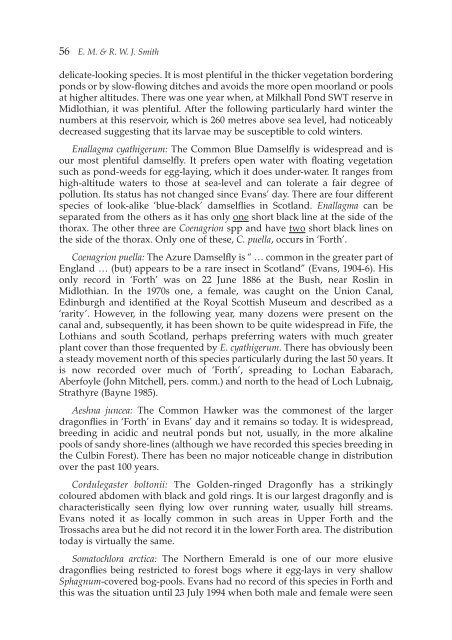the Forth Naturalist Historian - Forth Naturalist and Historian ...
the Forth Naturalist Historian - Forth Naturalist and Historian ...
the Forth Naturalist Historian - Forth Naturalist and Historian ...
You also want an ePaper? Increase the reach of your titles
YUMPU automatically turns print PDFs into web optimized ePapers that Google loves.
56 E. M. & R. W. J. Smith<br />
delicate-looking species. It is most plentiful in <strong>the</strong> thicker vegetation bordering<br />
ponds or by slow-flowing ditches <strong>and</strong> avoids <strong>the</strong> more open moorl<strong>and</strong> or pools<br />
at higher altitudes. There was one year when, at Milkhall Pond SWT reserve in<br />
Midlothian, it was plentiful. After <strong>the</strong> following particularly hard winter <strong>the</strong><br />
numbers at this reservoir, which is 260 metres above sea level, had noticeably<br />
decreased suggesting that its larvae may be susceptible to cold winters.<br />
Enallagma cyathigerum: The Common Blue Damselfly is widespread <strong>and</strong> is<br />
our most plentiful damselfly. It prefers open water with floating vegetation<br />
such as pond-weeds for egg-laying, which it does under-water. It ranges from<br />
high-altitude waters to those at sea-level <strong>and</strong> can tolerate a fair degree of<br />
pollution. Its status has not changed since Evans’ day. There are four different<br />
species of look-alike ‘blue-black’ damselflies in Scotl<strong>and</strong>. Enallagma can be<br />
separated from <strong>the</strong> o<strong>the</strong>rs as it has only one short black line at <strong>the</strong> side of <strong>the</strong><br />
thorax. The o<strong>the</strong>r three are Coenagrion spp <strong>and</strong> have two short black lines on<br />
<strong>the</strong> side of <strong>the</strong> thorax. Only one of <strong>the</strong>se, C. puella, occurs in ‘<strong>Forth</strong>’.<br />
Coenagrion puella: The Azure Damselfly is “ … common in <strong>the</strong> greater part of<br />
Engl<strong>and</strong> … (but) appears to be a rare insect in Scotl<strong>and</strong>” (Evans, 1904-6). His<br />
only record in ‘<strong>Forth</strong>’ was on 22 June 1886 at <strong>the</strong> Bush, near Roslin in<br />
Midlothian. In <strong>the</strong> 1970s one, a female, was caught on <strong>the</strong> Union Canal,<br />
Edinburgh <strong>and</strong> identified at <strong>the</strong> Royal Scottish Museum <strong>and</strong> described as a<br />
‘rarity’. However, in <strong>the</strong> following year, many dozens were present on <strong>the</strong><br />
canal <strong>and</strong>, subsequently, it has been shown to be quite widespread in Fife, <strong>the</strong><br />
Lothians <strong>and</strong> south Scotl<strong>and</strong>, perhaps preferring waters with much greater<br />
plant cover than those frequented by E. cyathigerum. There has obviously been<br />
a steady movement north of this species particularly during <strong>the</strong> last 50 years. It<br />
is now recorded over much of ‘<strong>Forth</strong>’, spreading to Lochan Eabarach,<br />
Aberfoyle (John Mitchell, pers. comm.) <strong>and</strong> north to <strong>the</strong> head of Loch Lubnaig,<br />
Strathyre (Bayne 1985).<br />
Aeshna juncea: The Common Hawker was <strong>the</strong> commonest of <strong>the</strong> larger<br />
dragonflies in ‘<strong>Forth</strong>’ in Evans’ day <strong>and</strong> it remains so today. It is widespread,<br />
breeding in acidic <strong>and</strong> neutral ponds but not, usually, in <strong>the</strong> more alkaline<br />
pools of s<strong>and</strong>y shore-lines (although we have recorded this species breeding in<br />
<strong>the</strong> Culbin Forest). There has been no major noticeable change in distribution<br />
over <strong>the</strong> past 100 years.<br />
Cordulegaster boltonii: The Golden-ringed Dragonfly has a strikingly<br />
coloured abdomen with black <strong>and</strong> gold rings. It is our largest dragonfly <strong>and</strong> is<br />
characteristically seen flying low over running water, usually hill streams.<br />
Evans noted it as locally common in such areas in Upper <strong>Forth</strong> <strong>and</strong> <strong>the</strong><br />
Trossachs area but he did not record it in <strong>the</strong> lower <strong>Forth</strong> area. The distribution<br />
today is virtually <strong>the</strong> same.<br />
Somatochlora arctica: The Nor<strong>the</strong>rn Emerald is one of our more elusive<br />
dragonflies being restricted to forest bogs where it egg-lays in very shallow<br />
Sphagnum-covered bog-pools. Evans had no record of this species in <strong>Forth</strong> <strong>and</strong><br />
this was <strong>the</strong> situation until 23 July 1994 when both male <strong>and</strong> female were seen



